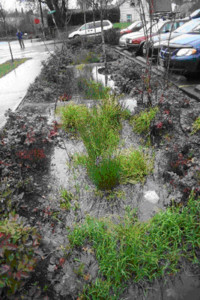The average rainfall per year in Chicago is 34 inches. The amount of water shed from a 2,500 square foot roof per year is 56,000 gallons. The focus now, with all of the talk about sustainability, is to retain water on-site. This article will discuss one way to do this and will discuss the benefits of bioswales.
What are bioswales? They are described as “gently sloped, vegetated ditches that slow the flow of rainwater runoff into the sewer system”. The names “grassy swale”, “vegetative filter” and “vegetative infiltration basin” represent different types of bioswales. They are designed specifically to temporarily store and infiltrate stormwater. Bioswales can reduce runoff volumes and rates by slowing water down through the vegetation, allowing ground water to recharge.
Bioswales are often planted with deep-rooted native grasses and forbs that enhance infiltration, cooling and cleansing of water in order to improve water quality.
Bioswales are often employed around commercial buildings and parking lots to help absorb stormwater runoff and pollutants. Other applications are at downspouts to slow and direct rooftop rainwater and along any hard, impervious surface to slow rainwater.
Numerous physical and biological processes take place within a bioswale or rain garden: evaporation, evapotranspiration, adsorption, filtration, plant nutrient update, microbial activity, decomposition and volatilization. Historically, these natural processes do not co-occur in our urban landscapes.
Consider creating one of these on your property or being an advocate for the use of bioswales in our communities. Not only would they add aesthetically, they are excellent for wildlife and biodiversity in our environment.

